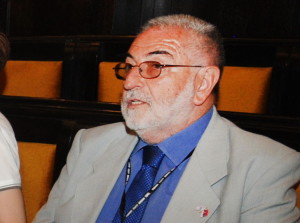
Union of Jewish Communities of Serbia, Belgrade
MEMORY IS NOT ENOUGH
MEMORY: There is individual, the personal memory primarily of all those who survived concentration and death camps. Unfortunately, already tomorrow none of the surviving camp inmates are going to be amongst us. There is also a public memory such as international remembrance days, when a state remembers victims and terrible crimes once a year (through speeches made by representatives of authorities). That public memorialisation is in fact a part of political obligations of states. States submit annual reports about those memorial days saying that they have successfully marked them and by that fulfilled their obligation. To public memorialisation also belong monuments -enormous, expensive and often difficult to understand – and they serve for wreaths to be laid and speeches to be held. As a rule, those monuments do not have any information on them so that a passer-by would find out something about the victims or the crime. Nowhere at Staro sajmište (Old Fairground) in Belgrade, at the location where Judenlager Semlin was, can one find a single word saying that 6800 Jews died there, mostly women and children. There are two monuments, both for fighters, anti-fascists, but not a single word about the Jewish women and children. This type of memory lacks a moral, historical, educational and humane dimension.
RESEARCH: In regards to Jadovno, there are almost no original documents. Efforts made by honourable people who are dedicated to research, collecting data and revealing the truth are invaluable. That sort of history, written on the basis of evidence, does not allow memories to fade.
At the Jewish History Museum in Belgrade there is a document titled GROUP JADOVNO filed under number 833, call number K. 24-5-1/1-1 to 1-3 which contains 229 names of Jews who died in Jadovno. When we know that the number of Jews who died in Jadovno is at least 1998, then we realise the importance of multidisciplinary research, recording of data and modern archiving of such materials. From the statement made by Dr Bela Hohsteter (JHM 1375, call number K.24-5-1/2-1) given and signed in front of witnesses, we find out that the authority in camps Danica, Jadovno and Gospić was in the hands of Ustashas. He testifies: “I know that the massacre of inmates in Jadovno was committed between 30 July and 2 or 3 August 1941, so certainly before the Italian occupation.” The statement by Dr Aleksandar Blivajs (JHM 1376 call number K.24-5-1/3-1) also given and signed in front of witnesses reads: “During my stay in Gospić I had the opportunity to see that Ustashas had all civil and political power in the area, so it is completely clear that the camp in Jadovno was under Ustasha jurisdiction and that the slaughter of inmates was their doing.” It is necessary to summarise data and facts from other texts as well, such as Šošković’s “Diary from Jadovno”, then the lecture of Dr Edo Neufeld held at the Gattkon refugee camp in Switzerland in December 1943 and published in book “We Survived… 3” published by the Union of Jewish Communities of Serbia, as well as the book by Dr Jaša Romano “Jews in Yugoslavia 1941–1945”. Special attention needs to be given to the book by David Anaf titled “Crimes of Fascist Occupying Forces and their Collaborators against Jews in Yugoslavia”. It is necessary to research, prove and keep records. If not, Richard Cohen is going to be right to say: “The last victim of genocide is the truth”.
EDUCATION: When a society does not educate its young people, it creates possibilities and gives room for intolerance, xenophobia, racism, hatred and anti-Semitism. Education means building moral values which are going to give spiritual and physical strength to any young man, regardless of his ethnicity or religion, to oppose the crime and any evil coming from ignorance, primitive behaviour and fear of otherness. And if young generations finally find out, and they need to find out and learn about it in schools, that those human-like creatures threw live men, women and children into the pits of Velebit where they were dying for days in a gruesome death, that they opened their bellies and shoved rocks inside so that they would sink to the sea floor. And when they find out, are they going to consider them role models, are they going to accept the same ideology, are they going to sing songs about them at town squares and stadiums, are they going to trample over their values in order to become monsters and disgrace of the nation they belong to? Every ethnicity has its good and bad people. Good, righteous people need to be role models for the youth. Our sacred duty is to educate young people and turn them into righteous ones.
